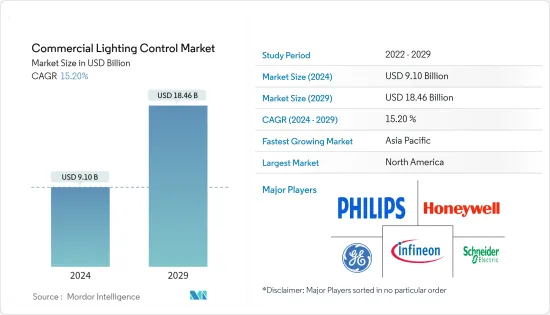PUBLISHER: Mordor Intelligence | PRODUCT CODE: 1521881

PUBLISHER: Mordor Intelligence | PRODUCT CODE: 1521881
Commercial Lighting Control - Market Share Analysis, Industry Trends & Statistics, Growth Forecasts (2024 - 2029)
The Commercial Lighting Control Market size is estimated at USD 9.10 billion in 2024, and is expected to reach USD 18.46 billion by 2029, growing at a CAGR of 15.20% during the forecast period (2024-2029).

* The growing economic growth of the developed countries, expansion of commercial buildings, rising awareness toward efficient lighting solutions, various government initiatives to promote LED adoption, etc., are the key factors driving the growth of the studied market. Many governments globally are rapidly phasing out inefficient light sources through performance standards, labeling, and incentive programs, including in Europe, where the transition to LEDs began over a decade ago. The European Union recently updated its regulations under the Ecodesign Directive and the Restriction of Hazardous Substances Directive to phase out virtually all fluorescent lighting in 2023.
* Rising commercial construction activities worldwide will create lucrative growth opportunities for the market. According to the National Bureau of Statistics of China, in 2023, the construction sector made up approximately 6.8% of China's GDP. Real estate and infrastructure construction are vital to the country's economy. During economic downturns, policymakers often invest in infrastructure to stimulate economic growth.
* Development projects involving smart infrastructures, such as new airport terminals, underground roads, and elevated railways, are rising in the countries. This is expected to spur the demand for the commercial lighting control market. However, the high cost of purchasing and installing smart solutions is hindering the market's growth.
* Macroeconomic factors, such as supply chain disruptions, such as natural disasters, and geopolitical tensions, can impact the availability of components, raw materials, and finished products, leading to delays in the production and delivery of LED drivers, sensors, Switches and Dimmers, Relay Units, and Gateways, thus hindering the market growth. Moreover, inadequate infrastructure development in rural and urban areas can hamper the adoption of lighting control, limiting market growth opportunities.
Commercial Lighting Control Market Trends
Hardware Segment to Witness a Significant Growth
* Connected lighting technology allows for even more savings. The light will automatically turn off when the user leaves the room. The lights will automatically dim when there is no vehicle or pedestrian movement on the road. Connectivity is also essential when leveraging data to enable the following transformation: data-driven services. The demand for commercial light control will increase over the forecast period, as it offers energy efficiency, which is a top priority, with LED lighting technology dominating the market due to its low energy consumption and longer lifespan.
* Additionally, sustainability drives customers to choose environmentally friendly lighting solutions that reduce their carbon footprint and save on energy costs. Human-focused lighting is becoming increasingly important in offices as people become more aware of its impact on their health and well-being. These lights support employees' circadian rhythms because they mimic natural light conditions.
* The growing demand for advanced lighting control systems also encourages vendors to form strategic partnerships, introduce new products, and gain a competitive edge in the commercial lighting control market. For instance, in April 2024, Acuity Brands Inc. introduced Connected STAR to its Emergency Lighting with Self-Testing Automated Reporting (STAR) system. This update improves code adherence for large-scale projects by offering a new deployment method that guarantees correct emergency functionality and lighting during power failures.
* India is a rapidly expanding market for connected lighting systems, as various State governments, local bodies, and sports authorities are demonstrating a growing interest in smart lighting systems. Furthermore, according to trading economics, in the fourth quarter of 2023, the construction sector in India was estimated to be worth more than INR 3.5 trillion, marking a substantial growth compared to earlier periods. Thus, India's growing commercial construction activities will leverage the demand for the studied market.
* Other factors creating growth opportunities for the commercial lighting control market include the rapid development of sensor and wireless technologies and the increasing demand for intelligent lighting solutions for developing street lighting and smart cities.
Asia-Pacific to Witness Significant Growth
Commercial Lighting Control Industry Overview
Additional Benefits:
TABLE OF CONTENTS
1 INTRODUCTION
- 1.1 Study Assumptions and Market Definition
- 1.2 Scope of the Study
2 RESEARCH METHODOLOGY
3 EXECUTIVE SUMMARY
4 MARKET INSIGHTS
- 4.1 Market Overview
- 4.2 Industry Attractiveness - Porter's Five Forces Analysis
- 4.2.1 Threat of New Entrants
- 4.2.2 Bargaining Power of Buyers/Consumers
5 MARKET DYNAMICS
6 MARKET SEGMENTATION
7 COMPETITIVE LANDSCAPE
8 INVESTMENT ANALYSIS
9 FUTURE OF THE MARKET




